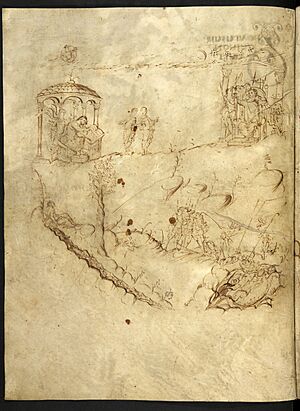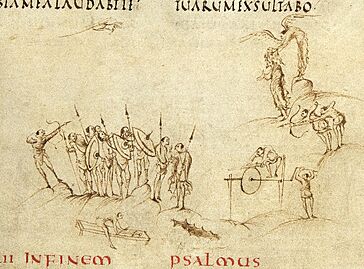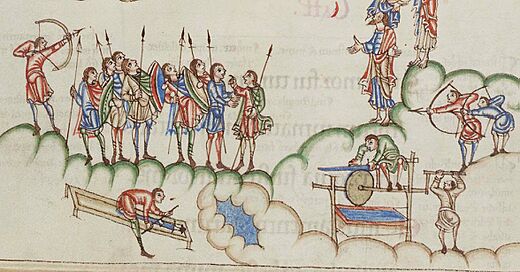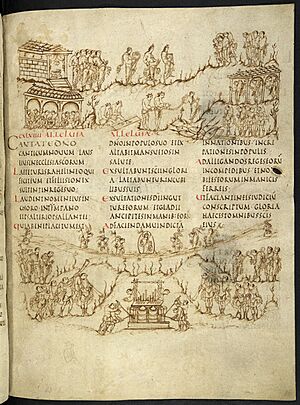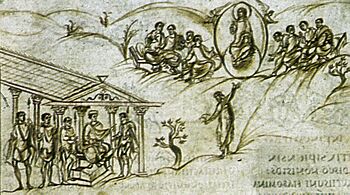Utrecht Psalter facts for kids
The Utrecht Psalter is a very old and special book from the 800s. It is a psalter, which means it contains the Book of Psalms from the Bible. This book is a famous example of Carolingian art and is probably the most valuable old book in the Netherlands.
It is well-known for its 166 lively drawings made with a pen. Each drawing goes with a psalm or other text in the book. For a long time, from about the year 1000 to 1640, the psalter was in England. It had a big impact on Anglo-Saxon art there, creating a style called the "Utrecht style." People made at least three copies of this book during the Middle Ages.
Besides the Psalms, the book also has other religious songs called canticles and hymns. These were used in daily church services. One important text included is the Athanasian Creed.
Contents
History of the Psalter
The Utrecht Psalter has 108 pages made from vellum, which is a type of treated animal skin. Each page is about 13 by 10 inches (33 by 25 cm) in size. The pages were put together in groups of eight. The book likely started with a picture of David, who wrote many psalms. The first surviving text begins with a large, fancy letter. This letter has a special design called interlace, which was common in Insular art.
How Old Is It?
For a while, people thought the psalter was from the 500s. This was because it used an old style of writing called rustic capitals. By the 800s, this writing style was not common in books anymore. However, experts now believe these are copies of the old style. So, the book is dated to the 800s.
Some people think the Utrecht Psalter was a choir book. This means several monks could read it at the same time while singing. Another idea is that it was for young monks learning the Psalms by heart in groups. This might explain why it has so many drawings.
Where It Was Made
Experts believe the psalter was made near Reims, a city in France. Its art style is similar to another famous book from that area, the Ebbo Gospels. It might have been paid for by Ebbo, Archbishop of Reims, so it is usually dated between 816 and 835. Other experts suggest it was made around 850. They think the drawings might show ideas from the travels of Gottschalk of Orbais. Also, some details, like the drawing with the Athanasian Creed, seem to fit better with Ebbo's successor, Hincmar.
Journey to England
The manuscript may have spent some time in the late 800s near Metz, possibly at the court of Charles the Bald. Art from that area shows its influence. By about the year 1000, the book had reached Canterbury Cathedral in England. This is when people started making copies of it.
Famous Copies
The Utrecht Psalter was copied completely three times during the Middle Ages:
- The first copy is the Harley Psalter. It is now in the British Library.
- The second copy is the Eadwine Psalter, made between 1155 and 1160. It has even more text, with five versions of each psalm.
- The last copy is the "Anglo-Catalan Psalter" from 1180-1190. This one is very beautiful, with full color and gold backgrounds. An English artist started half of the drawings, and a Catalan artist finished it later, using a different Gothic style. The drawings in this copy are simpler, with fewer figures.
Other artworks also copied ideas from the Utrecht Psalter. For example, similar groups of figures appear on an old Carolingian engraved crystal and on some old ivory carvings.
Return to Utrecht
The original manuscript stayed at Canterbury for at least 200 years after the year 1000. After the English Dissolution of the Monasteries (when monasteries were closed), the book came into the hands of Robert Bruce Cotton. He was a famous English collector of old things. He had the book rebound with his family's symbol on the cover.
Cotton lent the book to another collector, Thomas Howard, Earl of Arundel. Howard took it with him when he went into exile during the English Civil War. Around 1642, the book was taken to the Netherlands. After Howard's death, his wife and son sold it. In 1716, it arrived at Utrecht University and became part of the University Library. People rediscovered it in the library in 1858.
The Drawings (Illumination)
The Utrecht Psalter is full of amazing drawings for each psalm. These miniatures are outline drawings made with plain bistre, a brownish color. This technique became popular during the Carolingian Renaissance. It was cheaper and faster than making full-color illustrations.
The Utrecht Psalter is very special because of how many drawings it has, how big they are, and how many small figures are in them. Usually, Gospel books were the main focus for such detailed art during this time.
Influence on Art
The Utrecht Psalter was very important for the growth of Anglo-Saxon art in the late 900s. Anglo-Saxon artists used and changed its art style. While this one book probably didn't start a whole new art movement by itself, the style that came from it is sometimes called the 'Utrecht' style of outline drawing. This style lasted almost unchanged into the 1020s.
Style of the Drawings
The drawings are very lively and dramatic. They show lots of action, with leaping creatures and flowing clothes. The backgrounds are lightly sketched landscapes that stretch across the whole page.
Unlike most old Psalter decorations, which showed general stories or symbols, the Utrecht Psalter shows a very exact picture for almost every line of each Psalm. All these ideas are combined into one big scene. This scene is placed right before the psalm it illustrates.
It's not clear why the book was illustrated in this unusual way. Some believe it was to help people remember the psalm texts more easily. They could link each line to a striking picture, like a memory trick. However, these combined images sometimes go beyond just the words. They include scenes from the New Testament or other Christian symbols. Even though the style is unique, experts have found that eight different artists worked on the drawings.
Other Similar Books
The Utrecht Psalter is the earliest and most illustrated of a group of "storytelling" Carolingian Psalters. The drawings in these books are much freer. This might mean they were made for monks, rather than for the court or for use at the altar. The images don't have frames, and they are often very original in their iconography (the symbols and meanings in the art). They show a "liveliness of mind and independence" not found in more formal books.
Other books in this group include the Golden Psalter of St. Gall and the Drogo Sacramentary. The Drogo Sacramentary was important because it put most of its drawings inside the first letters of words. The Byzantine Chludov Psalter from the East shows a similar style. Artists who were escaping Byzantine iconoclasm (when religious images were destroyed) also influenced the Reims style.
Copying Older Art
Some experts, like Meyer Schapiro, think that the Psalter's drawings copied illustrations from a much older book, perhaps from the 300s or 400s. Details in the art led him to believe there was an in-between "Latin model" from after 700. Most experts now agree that the drawings are based on an earlier manuscript, even if they disagree on the exact details and dates of those older versions.
The drawing for Psalm 27 shows people "going down into the pit." Winged figures poke "evil-doers" with spears. On the left, a king stands before a temple. Christ and his angels are shown above. An umbrella held over the king was seen as strong proof that an Anglo-Saxon artist did not make the manuscript.
The drawing for Psalm 115 shows a crucifixion. A chalice catches the blood flowing from Christ's side. The earliest similar images are from the Drogo Sacramentary (840–855) and an ivory from the Pericopes of Henry II (840–870). This drawing is one reason some argue for a later date for the Utrecht Psalter. If it was made before 835, it would be much older than other known examples of this theme from the Carolingian period.
According to Gertrud Schiller, this manuscript has the first Western images that show Christ dead on the cross, with his eyes closed. However, it is hard to tell from such small drawings.
Other Texts in the Book
Like many psalters, this book includes various canticles and other writings after the Psalms. These include:
- Canticles of Isaiah the Prophet (Is 12 and Is 38)
- A third Canticle of Isaiah (1 Samuel 2:1-10)
- The canticle of Moses the Prophet (Ex 15:1-13)
- The canticle of Habakkuk (Hab 3)
- The canticle of Moses to the children of Israel (Deut 32:1-43)
- The blessing of the three children (from The Prayer of Azariah and Song of the Three Holy Children)
- The Te Deum, a hymn often linked to St. Ambrose
- The Benedictus of Zachary (Luke 1:68-79), with a drawing of the birth of Jesus
- The Magnificat (Luke 1:46-55). The drawing for this shows the Virgin Mary holding a small child. This child is not Jesus, but represents her "spirit."
- The Nunc Dimittis (Luke 2:29-32), which includes the Gloria in Excelsis.
- The “Oratio Dominica secundum Matheum” (Matt 6:9-13), or the Lord's Prayer.
- The Apostles' Creed on the same page. In its drawing, the Virgin Mary holds the child Jesus, who has a cross-shaped halo.
Next comes the Athanasian Creed. The drawing for this shows a group of church leaders. A central figure wears the pallium, a special cloth worn by an archbishop. This figure might be Athanasius at the Council of Nicea, or it could be Ebbo, or just a general image of an archbishop representing correct church teachings.
The psalter's creed was mentioned by James Ussher in 1647 when the book was in the Cotton library. But it was gone by 1723. When the psalter was found again in the 1800s, some thought it was the oldest book with the Latin text of this creed. This was because they thought the psalter was from the 500s. However, the oldest known books with the Athanasian creed are from the late 700s. After this, there is an "Apocryphal psalm," Psalm 151.
The Psalter is also bound with 12 pages from a different Gospel book. These pages are written in uncial letters, an old style of writing. They are from around 700 and show signs of being written by an Anglo-Saxon scribe. This is the only other text identified as being by the same scribe who wrote the St Cuthbert Gospel. That scribe worked at Monkwearmouth-Jarrow Abbey. The psalter was once also bound with the Reculver charter, but this was later removed. Robert Cotton might have bound them together because their page sizes were similar.



